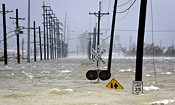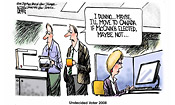A Brief History of Fannie Mae and Freddie Mac
Fannie Mae and Freddie Mac are in trouble. That much even the occasional reader of newspaper headlines knows. But who are they, exactly, and what have they done to prompt the federal government to announce it was standing by with a possible multibillion-dollar bailout?
Related Articles
Behind the Fannie and Freddie Fears
All debt issued by mortgage giants Fannie Mae and Freddie Mac comes with a prominent disclaimer: "No...
Business Notes
FISHING A Harpoon for Japan’s Whalers Under pressure from the U.S., Japan agreed last November to ...
Subprime’s Silver Lining
In early March, Boston College management professor Alicia Munnell gave a lecture at Yale on pensio...
Fannie Mae and Freddie Mac are America's two largest mortgage companies, together holding or guaranteeing some $5 trillion in debt. Their names are semi-acronyms for their original government monikers: the Federal National Mortgage Association (Fannie) and the Federal Home Loan Mortgage Corporation (Freddie).
During the Great Depression, as borrowers defaulted on mortgages en masse and banks found themselves strapped for cash, President Franklin D. Roosevelt and Congress created Fannie Mae in 1938 in order to buy mortgages from lenders, freeing up capital that could go to other borrowers. Although Fannie Mae began with just $1 billion in purchasing power, the agency helped usher in a new generation of American home ownership, paving the way for banks to loan money to low- and middle-income buyers who otherwise might not have been considered creditworthy. Fannie Mae grew so large over the years that in 1968, with the pressures of the Vietnam War straining the national budget, President Lyndon Johnson took Fannie Mae's debt portfolio off the government balance sheet; Fannie Mae was converted into a publicly traded company owned by investors. Two years later, Freddie Mac was launched, primarily to keep Fannie Mae from functioning as a monopoly. It went public in 1989.
Today, the two companies dominate the mortgage market, partly because of the belief that loans backed by Freddie and Fannie carry an implicit government guarantee: the companies are so large that the government would never allow them to fail. Accounting scandals in recent years have cost Fannie Mae hundreds of millions of dollars, but it has weathered these storms, in part due to its close relationship with Washington. Historically, conservatives have been Fannie and Freddie's most vocal critics, arguing that the companies' ties to government give them an unfair advantage over others in the industry.
Fannie and Freddie raise cash to buy mortgages from a variety of sources, including pension funds, mutual funds and foreign governments. Their influence on economies at home and abroad is pervasive enough that the Federal Reserve and the U.S. Treasury felt they had little choice but to offer assurances that the companies will not be permitted to collapse from reverberations of the sub-prime mortgage debacle.
In some ways, the Federal Reserve's current promise to loan the companies money, along with the Treasury Dept.'s proposal to invest in them if it becomes necesary, echo the days when the government first stepped into the mortgage market. Just as it was in 1938, the idea is to use tax dollars to prevent a complete meltdown in the U.S. financial sector that could trigger a global panic. We're not in a Great Depression, but the intervention is an indication of how concerned the government is about more turmoil to come.

 Pictures of the Week
Pictures of the Week Is Global Warming Worsening Hurricanes?
Is Global Warming Worsening Hurricanes? Kate Betts, Isaac Mizrahi and Joel Stein's Blog
Kate Betts, Isaac Mizrahi and Joel Stein's Blog Cartoons of the Week
Cartoons of the Week Sarah Lyall on Why the Brits Are Different
Sarah Lyall on Why the Brits Are Different Damien Hirst: Bad Boy Makes Good
Damien Hirst: Bad Boy Makes Good Could Florida Survive the Big One?
Could Florida Survive the Big One? Afghan Civilian Deaths: A Rising Toll
Afghan Civilian Deaths: A Rising Toll The Wrestler: Mickey Rourke's Comeback
The Wrestler: Mickey Rourke's Comeback How Fast Should Iraq Re-Arm?
How Fast Should Iraq Re-Arm?